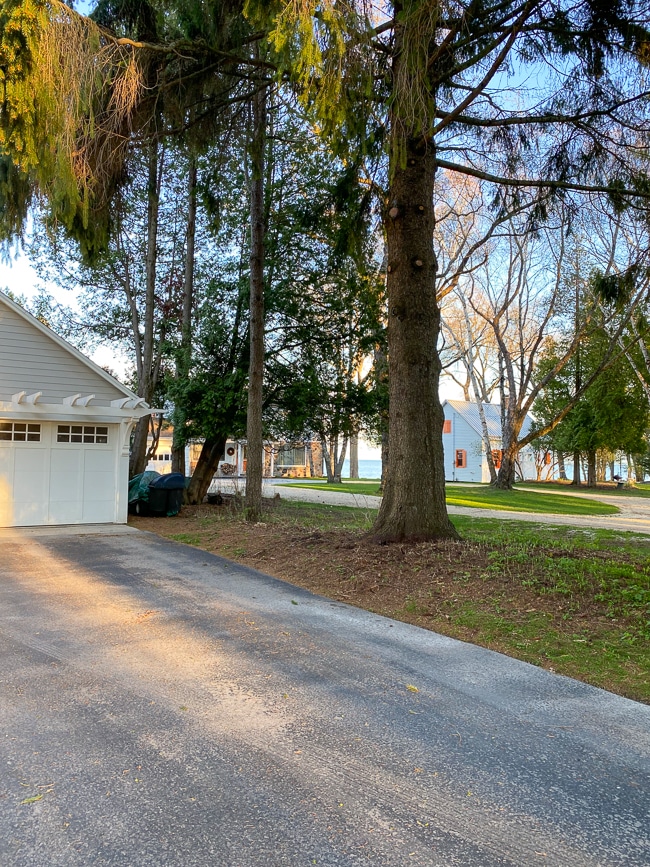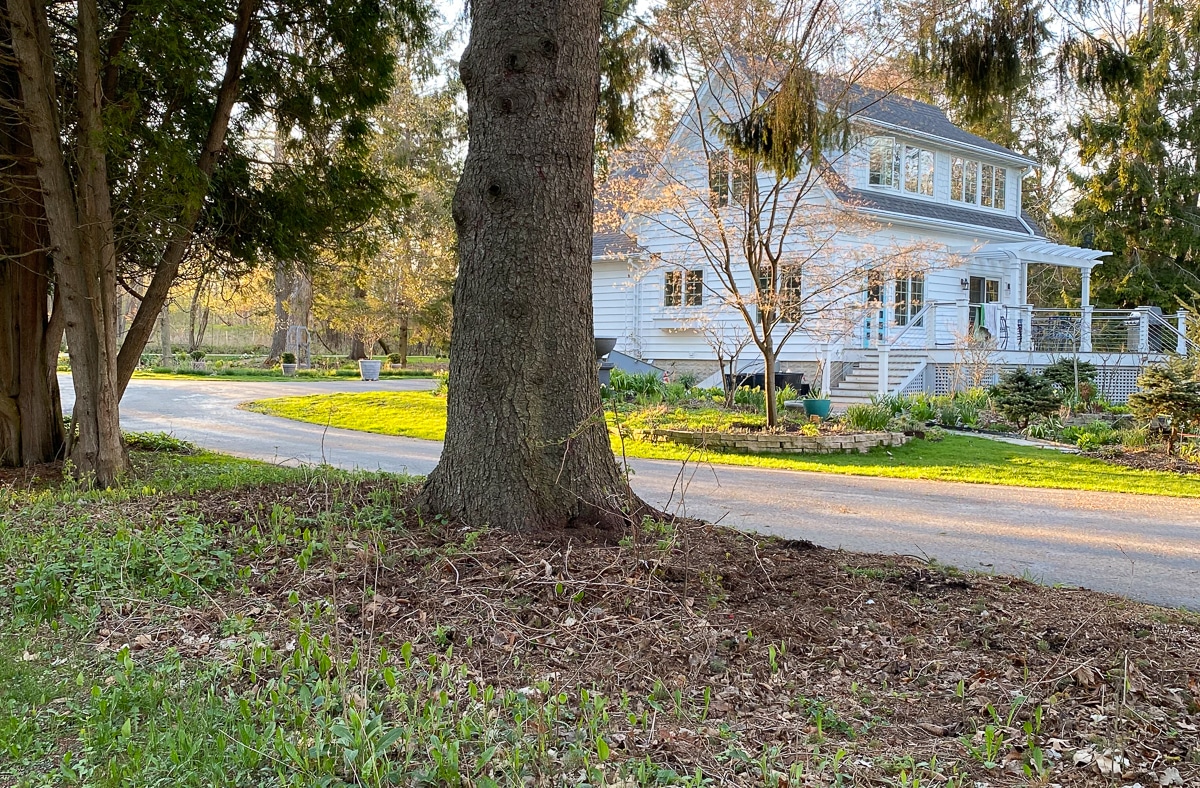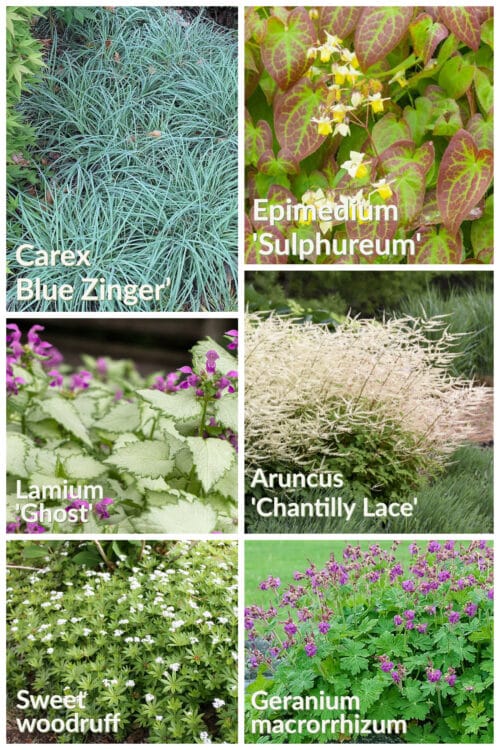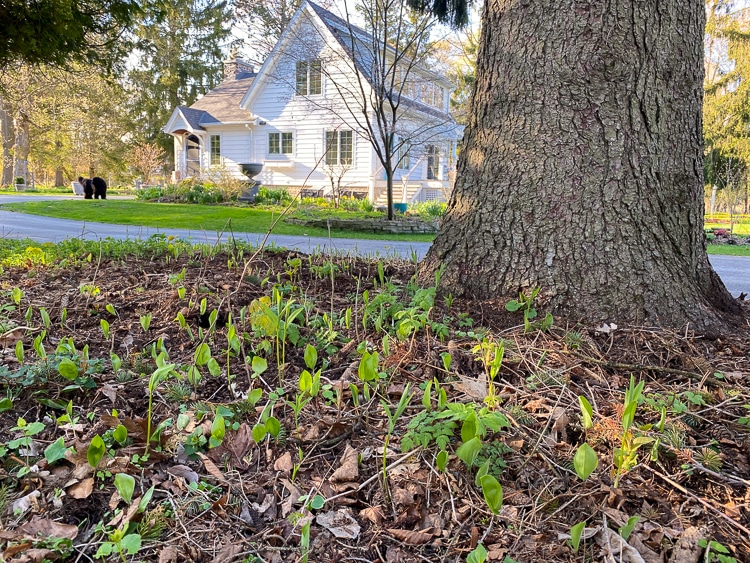This post is sponsored by Troy-Bilt, maker of great equipment to whip your yard into shape and supporters of neighbors helping neighbors. As usual, all thoughts are my own.
Isn’t it funny how we limit our gardens to the little square of land we own? Obviously there’s a reason for this, but if the only thing stopping us from blurring those lines is who owns what, then maybe it’s not so hard to change that situation.
And that’s exactly what we’re doing with a new garden project this year. Our driveway is separated from the neighbors’ driveway by about 30 feet and much of that lot line is bordered by mature cedar trees pruned up to about 7 feet by the deer. But close to our garage there is an open area, in part because some dead trees were cleared last year.
It’s a bit jarring to have this random open area on an otherwise nicely wooded lot line, and weeds love a bit of open ground, so it gets a bit scruffier looking every day.

So I came up with the idea of small garden there. Maybe not even a garden, per se, but a bit of planting to make it look a little prettier and keep the weeds from taking over. And when I asked the neighbors what they thought of the idea, they were all in with the idea of planting both sides of the lot line for a combined garden area.
THE CHALLENGES
This project is not an easy plop-in-plants kind of garden. There are significant challenges to account for.

The first is that much of it is in shade, dappled on the neighbors’ side and pretty much full shade on our side. That’s because this area is dominated by an enormous Norway spruce, which also means we’re talking about dry shade, an additional complicating factor. But there’s a hopeful sign: those weeds. Rather than view the weeds as another obstacle, I see them as a beacon of hope, because if weeds will grow in an area, there’s a plant that will grow there too.

There’s also an unusual soil challenge here. We have an insanely active squirrel population here and they love sitting in this tree and shredding pinecones, which means that the base of the tree is covered in more than a foot of shredded pinecones. I know how weird this sounds, but I’ve been digging them out for a couple weeks now and they just keep coming. There’s also a lot of needles built up in the area, so I need to dig out a bit so we can get to actual soil.
I’ve been slowly working my way through the layers with a rake and shovel and then I’ll follow it up with this light (key factor) but powerful leaf blower to deal with the bottom layer.
PLANTS
The plant palette has additional requirements as well. In addition to being tolerant of shade and dry soil, the plants in this area will need to be low maintenance. None of us are looking for more maintenance, so a once-a-year cutback is about as much work as we’re up for over the long haul.
They also need to be deer resistant, because this can be a deer thoroughfare. And, most importantly, at least from my perspective, is that they need to be low growing, because we happen to enjoy a nice little view of a slice of Lake Michigan through our neighbor’s yard and we don’t want to do anything to interfere with that. Neither set of neighbors is trying to hide what’s next door, just make it a bit prettier.

As you might imagine, that narrows the list of plants down considerably, but I’ve found a good selection that I think will do well.
Aruncus ‘Chantilly Lace’ (aka goatsbeard): Although some goatsbeards can grow quite tall, which is a rather lovely addition to most shade borders, ‘Chantilly Lace’ stays about 30 inches tall. It has frothy white flowers that continue to look good after they are spent, but can be removed for neatness.
Epimedium x versicolor ‘Sulfureum’: Epimediums are a go-to plant for dry shade and also happen to be a favorite of mine. ‘Sulfureum’ tends to spread pretty easily, which is exactly what I’m hoping for. The small yellow flowers are pretty but the foliage is equally attractive.
Geranium macrorrhizum ‘Bevan’s Variety’: If you know me, you probably knew this one was coming. This is perhaps my No. 1 go-to groundcover for every condition. I have it growing under the nearby cedar trees and although it doesn’t grow with the same vigor it does in sunnier, wetter spots, it does grow.
Carex flauca ‘Blue Zinger’: This sedge has taken a bit of a hit to its reputation lately because some places have stopped selling it because of its propensity to spread aggressively. I used it in the new garden last year and was a little concerned but I reached out to Roy Diblik, who occasionally uses it in his designs, and he said he’s not too worried about it spreading uncontrollably in shady spots. My hope is that the challenging location will keep it in check while still allowing it to fill in nicely.
Lamium ‘Ghost’: Lamium is another tough-as-nails groundcover that can be a bit too happy in some areas but I think will be kept in check in this area. Because of its nearly white foliage it can be a little hard to work into a design, but it definitely brightens up dark spots.
Gallium odoratum (sweet woodruff): Conveniently there is already sweet woodruff growing in this year. I think it’s a great groundcover, although its seed heads tend to stick in the dogs’ fur a bit like burrs (although not as difficult to remove). I’ll supplement what’s growing there with bits of it from elsewhere in the garden. It is one of the most effective weed suppressants I’ve found.
THE PLAN
First off, the overriding plan is to not let this become a huge project. I am no stranger to big, labor-intensive projects but we all have only so much room in our lives for those. I believe that creating this little piece of shared beauty doesn’t have to be a weekend consuming project.
As I’ve mentioned, the first step is to manage the needle/pinecone situation and expose some actual soil. I’ve already pulled many of the weeds there, primarily small wild raspberries and a bit of garlic mustard weed. Any other weeds that are unearthed will need to be pulled or rooted out with a hoe.

This same neighbor also has a lovely pile of decaying leaves, so I’ll bring in a bit of that leaf mold to serve as a mulch that will break down to add some goodness to the soil and help with moisture retention. If the leaves need a bit more breaking down I can use this chipper shredder vac to chop them up smaller so they break down more quickly and make an even better mulch.
After that it’s all about the planting. My plan is to lay out the plants with the neighbors to make sure we all like it and of course, leave a bit of room for a path so we can walk through for visits.
There is a bit of work after the fact here. It will be crucial to water these plants regularly this year so they are well established. If we can get them off to a good start this year, hopefully they won’t need much attention in the future.
WHAT DO YOU THINK?
To be honest I love this idea and the ability to blur the lot line a bit, not to mention it feels good to work together with the neighbors.
So what do you think? Would you work with a neighbor to share a little bit of beauty?
I’ll update the whole process and the end result (at least for this year) in an upcoming YouTube video, so stay tuned there for more.


21 Responses
Discussing it with the neighbors beforehand is essential. That’s an important step. Inviting ideas, not just telling or forcing.
You have a wonderful garden and lovely personality. Thank you for sharing it with us!
I am nurturing a dry shade garden under Norway maple in Zone 5a. I started a garden in this spot 4 years ago by adding soil (about 6-9 inches) on top of the existing ground and roots. The tree roots are very shallow, and the ground is so dry here. The garden looked good for a while, but after 2-3 years my purple lamium, heuchera, and tiarella were getting smaller every year and nothing was blooming. Even the groundcover geranium – Biokovo – I think – refused to spread or bloom. The only plants that have done well at this site are hosta – and I don’t at all have a problem with slugs – maybe because the ground is too dry? I have Lysmichaia aurea – which I’ve been warned can spread aggressively – and it grows only about 1 foot out and sparsley per year here- hardly aggressive at all. It contrasts well with chocolate chip ajuga – which must be tough as nails as it is also okay in this super dry and shady location with the tree root competion. Spring flowering bulbs have also been fine here -Akebono tulips even return despite the shade – I think they like it dry. Daffodil was fine. I have a lemony lace Sambucus that was doing okay here – I am sure it would have grown better elsewhere, but it continued to grow and I appreciated having something sizable to contrast with all my hostas. I had epimedium here and it did not do well, despite the reputation for tolerating dry shade. – it nearly died Ultimately, I dug out all the heuchera, tiarella, geranium, and lamium In doing so, it was amazing how many tree roots had managed to integrate themselves with those of the plants. I am putitng some other plants back in, but this time I have dug in some hidden containers – buried in the soil – and the lamium and heuchera is thriving again. I hope your dry shade and tree root competion is not as severe as my own. Like Norway maples, I think pine trees have kind of a bad rep for being a challenging area to grow in. I have also augmented my garden with containers above the ground as well – I have added some bleeding heart in a tall container along a fence, and I am hoping it will survive as it is cold hardy to zone 3… and I am in 5. I think it will take a few more years to see how everything grows in hidden containers.
I have one patch that is shared with my neighbor. We underplanted a lovely pine tree with pachysandra that she was digging up from another part of her garden. It has made a lovely groundcover over the years. Sadly the pine tree is no more and now a new neighbor has moved in. She and I are now discussing what we can do under the row of Norway spruce trees that are on the border. They are now about 60 years old and the lower branches are dying and need to be limbed up. We both hate losing the privacy it has given up.
I never considered digging up the needles that blanket the area. I do find it extremely difficult to dig to plant anything under those trees. Small plugs would make it a little easier.
I love your plant selection. Where do you get plugs rather than pots of plants. I can’t afford to buy a dozens of potted plants at 10-20 dollars each.
I think your plant selection is great but here in zone 5 Aruncus Chantilly Lace will only grow in moist soil so it might not do well in a dry area under a pine tree. I had to add lots of compost to the soil in order to get Aruncus to grow here. And occasionally I still have to water it. Every fall I add another ring of compost around the clump to keep the soil humus rich and moist. You might have to water yours since the pine tree will block the rain from reaching it. I have also mixed Miracle Grow moisture retentive potting soil into some of my bed – that too seems to help plants that like moisture (even though it’s really supposed to be for potted plants, I’ve used it mixed with compost and native soil for plants that grow in swamps such as Button Bush and Swamp Milkweed).
I love the Epimedium! Very under used plant and I just bought my 3rd variety that the leaves turn redish in the fall. PS – have shared a garden with our neighbors for 15 years and while it is mostly foundation plant basics we respect each other and keep things trimmed neatly.
Hmm that’s a great idea. I’m not sure that my neighbor (the house I can actually see would go for that. They have a bare minimum set of pink phlox beside the edges of their driveway and her husband keeps the grass scalped (seriously) like I don’t even know how he keeps it alive they don’t water it. They also aren’t very friendly so I would have to be the one to walk over and say “Hi, do you want to do a garden together or should we just leave these giant weeds between us?” Even if they liked the idea I doubt they would chip in on cost and its approx. 4-5 feet wide and 60 – 70 feet long. So my plan has been to put a bamboo screen up or possibly arborvitae. I don’t know. I think I need help there. Right now the weeds are about 5 feet high looks like hay and tall grass except for the large patch of white flowers where some blackberry bushes are (we have those on both sides of our yard) the other neighbors side of us is about an acre of thick woods so no need to do anything. I love your ideas and videos! I can’t wait to see how this turns out because I’ve just started a dry area, shade garden this passed weekend and I needed some more ideas to fill spots. I did buy some guac hosta and blue hosta, I will spray if necessary. I also got some velvet boxwood, love the bluish tinge. The boxwood might be to tall for what you want to achieve in your space, 24-30″ but they ARE very low maintainance and hardy in your zone. Anyway, can’t wait to see how it all evolves. Cheers!
It’s encouraging to read a successful gardener’s blog knowing they’re just as plant crazy as I am! I have to remind myself to “focus” and when a garden looks beautiful (with minimal maintenance) to leave well-enough alone! Last year I planted 3 dahlias in a garden that was already very full (but balanced and attractive.) The dahlias were too much (and I didn’t know how to take care of them properly…which is actually how I found you!) This year, I planned and planted a separate dahlia garden and can’t wait to see how it turns out! Thanks so much for all your tips, knowledge and inspiration!
I love your plan and am glad to read about others spreading the love of gardening to others. On my small street we started with three die-hard gardeners about 20 years ago and (slowly but surely) all but one of the other nine have “got with the plan.”
I was thinking, what if you strategically placed the goatsbeard to just in front of the trees or around them? That way if you don’t want to remove the blooms you don’t have to…. the blooms would stand out against the darkness of the bark and it wouldn’t obstruct your view of the lake ?
Great idea and I love your plant picks. Can’t wait to see how it all works out.
Great ideas, Thanks for this amazing guide.
I think it’s a great plan. I like the Blue Carex I haven’t seen that one but haven’t been to the greenhouses to check things out. I love the geraniums that you chose. They are so fragrant. I’m not a fan of the lamium. I had some and couldn’t get rid of them and to me they stink. If you don’t mind wild violets, they would look nice but they take over also. I’m not sure how deer resistant they are. I planted some ferns under my pines and they kind of took over. I am a rock person so I would have some unique rocks also. Can’t wait to see the end result!
Looking forward to a video on this or another blog. Great ideas.
Oh, I envy you that you have a neighbor that cares about plants, landscaping, and curb appeal. Mine has not worked in her yard except for hiring a grass cutter in the past 10 years. We put in screening shrubs/trees to separate and hide from the property line. Keep us posted!
I’ve had really good luck with ligularia under a tall pine tree on our driveway. The deer don’t eat it at all. I tore out all the weeds, replacing them with ligularia and it both looks great and multiplies well. I’m now having trouble finding it for another area I want to clean up, after a failed attempt to plant hosta and to treat regularly with Melorganite.
I do this with my neighbors. If they’re yard bugs me, I offer them plants, seeds or pruning to “encourage” them to get with my street beautification program. They now ask me about what to do with their containers.
The Silicon Valley techy across the street is so proud of the allysum and nasturtiums seeds I gave him that actually sprouted and are growing, he’s out there watering and enjoying his yard much more than when he first moved in.
It’s a satisfying process and I not longer am odd man out with my House and Garden worthy garden. It’s a great way to get to know your neighbors.
Absolutely. I planted tulips in the neighbors yard on the strip between our houses where I see it but they don’t. I’m hoping they’ll let me remove the grass and make it a bit of a meadow. They won’t need to mow and I can extend my planting. Your plant selection is perfect as always. Good luck!
Great idea! My neighbor & I have been maintaining a garden between our 2 houses for about 20 years. Dry part shade, part sun & rarely gets watered on purpose by either of us. I supplement w/ a few large pots of hosta. Deer weren’t a problem in the past, but that’s now changing. We have epimedium, many hellebore, several different ferns that handle dry shade, azaleas, toad lilies, bluebells, forget-me-nots, and some self seeders that migrate over from my larger gardens. This year we had several foxgloves surprise us. It’s been fun to add & subtract different things over the years as the sun/shade coverage has changed.
I would like to know more about the vacuum/mulcher! Will there be a vid of your using it? Your plant choice is spot on and super appropriate for an area in my yard bordering our neighbors!
This is encouraging cause on my property I have a deodondra tree and a Douglas fir tree and globs of weeds under them with an ample amount of pine ones and shredded pine cones from the squirrels. Thank you for this insight and I’ll look forward to the video!